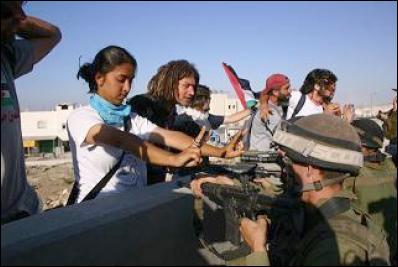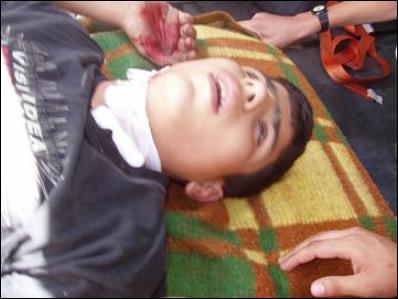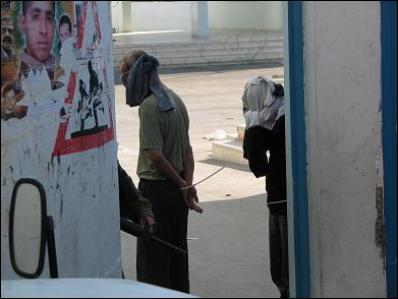Nablus: Extra-Judicial Executions Evidence Emerges
Nablus Massacre: Evidence of Extra-Judicial Executions - 11 year old girl killed by sniper - 35 injured – 6 Killed in Nablus, 4 in Jenin
September 15, 2004 Kole in Nablus
Israeli military operations in Nablus and Jenin
today have resulted "in the highest Palestinian death toll
in the West Bank for months" according to the BBC, while
Haaretz is claiming that today's killings constitute "the
highest single-day Palestinian death toll in the West Bank
for more than two years" (although that claim is
disputable). Early this morning Shayetet 13 commandoes
raided a building near Old Najah Street in an area of
Nablus inhabited by many Christian families not far from
the Latin Convent. Backed by tanks, Apaches, and armored
vehicles Israeli forces clashed with Palestinian militants
for two hours.
Several homes were occupied in the area, including the Latin Convent itself. By 5am, five Palestinian resistance activists were dead – including Nader Aswad (22), the new leader of the Al-Aqsa Brigades in Nablus, Abdel Halim Salem (22), Munham Abu Jamileh (24), Halim Aqqad (22), and Mohamed Mareh (23) - while another fighter on the scene is reported to have escaped. Medical teams were blocked from reaching the bodies by Israeli troops in the area until 11am. They were only allowed to pass after the IDF had ensured free passage for a D9 bulldozer, which was brought into Nablus to demolish part of the house used by the fighters. While medical teams were evacuating the bodies of the dead, 11-year old Mariam Al-Nakhleh, who was watching the medical teams from her balcony, was inexplicably shot in the head by an IDF sniper. The news of the killings sparked clashes between military units deployed throughout the city and stone throwing shebab since the morning. At least 35 people were injured in the ensuing confrontations. What fallows is a detailed report of today's events.
EXTRA JUDICIAL EXECUTIONS
As medical volunteers moved into the area of last night's clashes it quickly became clear that most of those killed had been killed at close range and most likely while they were already in Israeli custody. The scenes of scattered and bloodied corpses with gaping holes in their heads contrasted sharply with the tranquility and beauty of the secluded olive grove in which most of the men's bodies were found. Most of the wounds of the dead were evidently from close- up as the lethal shots completely obliterated the sides of the heads of three of the men. According to Basma Masri, a resident of Nablus quoted by the AP, her son - who was one of the fighters in the compound - told her over the phone last night that all of those present had run out of ammunition. One of the shaheeds had evidently been held up against a wall and shot just under the jaw scattering his blood and brain matter against the wall behind him and the neighboring storefront. Crowds stood dumbfounded at the scene of the crime, while some neighbors poured buckets of water to clear the pools of blood and flesh that had coalesced there.
If the extra-judicial executions are confirmed it would fit into a similar pattern of abuses perpetrated by Shayetet 13 naval commandos in Nablus earlier this summer. It should be recalled that this is the same unit responsible for the killing of two PFLP activists - one of which was also executed at close range while trying to surrender - during a similar night time raid on July 6, 2004, when tanks and Apaches were also deployed. Professor Khaled Salah and his son Mohamed were also killed that day by Israeli military snipers long after the clashes with the resistance fighters had ended. If confirmed, these latest executions – and the killing of Mariam – constitute grave violations of the Geneva Conventions and constitute serious war-crimes that should be investigated without further delay.
What follows are excerpts from an interview with Dr. Samir Abu Zaroor, the Director of Rafidia Hospital's Emergency Ward, who inspected the bodies as they were brought into the morgue:
ISM: What exactly happened to the men who were killed that we saw downstairs in the morgue just now?
Dr. Zaroor: Now the other martyrs you saw them now. Did you see that more than three of them were hit in the head and their heads are crushed and I think it is not only bullets, maybe heavy bullets, special ones. One of them, when I saw his body, I noticed a sign of his…of the soldiers boot on his chest. I think this was Munhem Abu Jamileh. A boot on the left breast of his chest. We made a picture of it. Now three of them were shot in the head. Actually four of them were shot in the head, sorry. The last [man] was [shot] in his chest. Multiple bullets he received in the chest. This kind of killing I think is…I think this man [Munhem] when they caught him he was alive and he was hit by the soldiers because I saw blue steps of the soldiers on his chest. It was blue, like a bruise and you could see outlines of the footprint of a soldiers boot. This is not the first time we saw killing carried out in this way. This is not the first time. Martyrs before this were also handled in this way. Some of our martyrs are sometimes shot and then bitten by dogs.
ISM: You think four of them were executed and one of them was shot in the chest?
Dr. Zaroor: Yes. You see the heads, I don't think it was from the automatic. From what is this? It is from close range. The martyrs were in a small area. If they wanted to [the military] could have caught them alive. If the soldiers wanted to they can catch them alive. Five men to stay with guns against those automatics! How many bullets do they have? 60? 90? Everyone, had maybe 60, something like two magazanim. There was one we saw shot in the neck and all the head out. Three of them, or four of them – sorry - are in the head. They hit him in the neck and his head came out behind. There was one, like a knife it wasn't a bullet. The other was shot in the neck and it blew the back of his head. How? Only if they shot him from close range is this possible.
ISM: So you think four of the men were executed at close range?
Dr. Zaroor: I think so. But look, surely 100% I cannot say what happened, surely I can't because I wasn't there. But there are signs. These signs push you to say that they were assassinated. These signs are that one of them was shot in the neck and the head came out. There are no eyes. This means it was very, very near. If there was distance, you would see inlet [Dr. Zaroor points to the front of his neck] and outlet [Dr. Zaroor points to the back of his neck], but not explosion [of the head]. This would be the case if they were shot from far. The other man also had a footprint on his chest. The third one, his arm…he had a cut wound on it, equal size. The wound if it is equal size means that it was a sharp knife that made it.
SNIPERS TARGET 11-YEAR OLD GIRL
One of the most noticeable things this morning about the scene where the armed clashes had been concentrated was the heavy presence of Israeli sniper teams in several occupied houses around the area. As a small group of ISMers went to negotiate the passage of medical teams to retrieve the bodies of those killed, we were confronted by two soldiers pointing their rifles at us from positions they had taken up around a nearby balcony. The experience was similar for several journalists and medical volunteers who found themselves at the wrong end of red laser-sights pointed in their direction. As the military was withdrawing, and people began hitting the streets again to look for those killed, it seems that 11-year old Mariam Al- Nakhleh was shot by a sniper in broad daylight (she was hit directly in the lower portion of the jaw). Mariam was proclaimed dead-on- arrival at the Emergency Ward in Rafidia Hospital.
Footage of the incident on local Nablus TV showed the lifeless corpse of the girl being carried by a male relative, blood streaming down her face and onto his white shirt. According to Dr. Zaroor, "You saw the girl? She is around 11 years old. She was killed in her home this morning. There were a lot of people. More than 200-300 on the streets and the soldier was in an occupied home and just shot one bullet. It was in her face and she went down. This was in the morning, at 10 or 11 o'clock. She was in her home. The bullet is in her right chin. Okay? She has a cut wound about 8cm by 4cm with fracture to the upper jaw and the lower jaw. Both. And the bullet was inside. Our kolega [colleague], the doctor in the operation room took [the bullet] out and I think she also had fracture in the base of the skull because she was bleeding from her nose. She died when she arrived [at the hospital]. In the operation room they couldn't do anything. I didn't see any vital signs. So I think that she died on arrival."
CONDITION OF THOSE INJURED IN THE CLASHES
Dr. Zaroor then explained the status of those injured in the confrontations between heavily armed soldiers in armored vehicles and stone-throwing youth: "I received about 10 [injured] in the morning by the time I finished my job at about 8:30am, but we today… we have received 22-23 patients today, that were wounded. Some of them are with live bullets the others with rubber. Also we have people that were admitted to our hospital with rubber injury. And the rubber bullet is inside them. There is one boy Allah, 16-17 [years old], that arrived with a rubber [bullet] injury in his left shoulder and the rubber bullet is inside him. The others…we had three who were hit by live bullets and they have many [bone] fractures. We have one boy 11-12 years he is in critical case, his brain is out and now he is in the ICU [Intensive Care Unit]. He was shot in the head. This critical case…I think he will pass away. The other one has multiple fractures in both thighs; he's also in the ICU. Another one he is from El Ein [refugee camp], he's 25 years old and his name is Hassan Qalbous. He was also injured in the head. We have three critical and one is likely to pass away. I think he is critical and I think he will pass."
By the time the day ended, the toll of injured casualties had reached 35. It should be noted that this number is a minimum, as it only includes those injured who were treated at the hospitals in the city and not those who received first aid on the streets or never reported their injuries to medical teams. At the ICU on the second floor, a doctor and some of the orderlies on hand give further information on those that are still in critical condition. The doctor who was watching over the critical cases takes us to the foot of the bed at which the 11 year old boy is being cared for. Exasperated, he explains the case: "He got a bullet directly to the head. We recorded an injury to brain tissues, grey blood cells and we then made a craniotomy for him. Now he's in a critical situation, we hooked him up to the machine and we hope he will be okay. It is a rubber bullet that hit him, but he had lost some of his brain-tissue when he came to the emergency unit. We made an operation, a craniotomy was done, and we also made a prediment for him and we made dressing. Now he's on a ventilator and his condition is critical. He came to the hospital at 12 o'clock, or 11 am."
The doctor then motioned to the neighboring bed, where a young man was twitching with a bandage wrapped around his head. "It is another injury. Mainly to the ear, along the ear [draws a line from his ear down towards his neck]. We made prediment and dressing. His wound is still open. Because it is open, it is not clean. This man is not crippled but his mentality is poor. So look at what kind of people they are injuring. He was mentally handicapped before the injury. He's 25 and saw the children throwing stones and he went with them. So this one has an injury below the ear, to the neck and his condition is unstable."
Finally, the doctor takes us to a third man who is in somewhat better condition as he is clearly conscious, but two bandages are around both of his thighs. The doctor continues, "This man was shot in the femur. Every 2-3 hours we make the dressing. There is oozing from the wound. We made an operation for him and he's under observation and still in a condition…you could say, moderate injury. A bullet injury to the femur. Fracture of the femur and compounded fracture. Two bullets. There is not a bone injury only; there is also a vascular injury. Two doctors here are working on his case; the orthopedic and the vascular surgeon are helping each other." The man in the bed interjects, "The Zionist military, they are all shit. They stole our land, they stole our country and now they are stealing our lives. There is no peace. I'm 33, I'm married I have three girls." The doctor looks on, "Like this man…you know? What he has to do? He's not involved!"
CONVENT RAIDED AND HOUSE DEMOLITION
Testimonies were also gathered from priests at the Latin Covent by two ISMers from New York. The Convent, which houses the Mother Theresa Society, was among several houses in the area that were raided and/or occupied by the Israeli military during last nights operations. One of the elderly priests described the scene: "They knocked very strong. I came down and they were scaring our sisters. I'm in the upstairs apartment and I saw them here. And the army came and then they took us to the room there. We stayed three hours in the room. I was in my bedroom when they started shooting. Maybe they could have killed me. The place where I sleep is at the same level as the road, so the bullet could come from the window to my bed. Now I will move my bed. They came inside at five in the morning and left at 11 and they had everyone in one room, sick women, and children. About three hours we were held. We couldn't move. I didn't hear that something was missing and ruined in the compound though other than the doors, the window, my bedroom, some furniture. We have two different apartments. One for me, one for the sisters. The soldiers had dogs to watch people. What does it mean? There was a dog with the soldiers."
The experience was repeated in several homes in the neighborhood. The interview with the priest was interrupted by two helicopter gun- ships that were circling Nablus this noon, after on-the-ground operations had already ended. Several rounds were fired at an undetermined location on the Gerizim mountain that lies on the southern edge of the city, again for no apparent reason other than to terrorize Nablus' already traumatized citizens. As medical teams scoured the area of the clashes an Israeli military issue grenade, rigged as a mine (with its pin out) was found in the olive grove. Some shebab carefully diffused the bomb, while others surveyed the damage to the nearby home that was demolished by the D9. By the evening many streets were littered with signs of confrontations and the mosques were reading updated statements drafted by the various political factions denouncing the execution-style murders.

Blocking soldiers from shooting
children at Qalandiya.

Palestinian boy hit in the
neck by a rubber bullet by Israeli soldiers during the march
to protest Israeli Army attacks in Nablus, August 21.

Palestinians Detained in
United Nations School During Israeli Army Raid
For photos see: http://www.palsolidarity.org


 World Vision: 3.5 Million Displaced Following Myanmar Earthquake And Ongoing Internal Conflict
World Vision: 3.5 Million Displaced Following Myanmar Earthquake And Ongoing Internal Conflict World Butchers Challenge: World’s Top Butchers From 14 Nations Go Knife-to-Knife In Paris
World Butchers Challenge: World’s Top Butchers From 14 Nations Go Knife-to-Knife In Paris Save The Children: ‘It Was Terrifying’ - Children Prepare To Spend Myanmar New Year Festival In Shelters Following Earthquake
Save The Children: ‘It Was Terrifying’ - Children Prepare To Spend Myanmar New Year Festival In Shelters Following Earthquake Global Forest Coalition: Global NGOs Call On International Maritime Org To Reject Biofuels And Commit To Truly Clean Energy
Global Forest Coalition: Global NGOs Call On International Maritime Org To Reject Biofuels And Commit To Truly Clean Energy Australian Catholic University: Principals Navigate Growing Challenges As Anxiety, Depression Increase And Violence, Workloads Intensify
Australian Catholic University: Principals Navigate Growing Challenges As Anxiety, Depression Increase And Violence, Workloads Intensify SNAP: Survivors Deliver Vos Estis Lux Mundi Complaints Against Six Cardinals To Vatican Secretary Of State Parolin
SNAP: Survivors Deliver Vos Estis Lux Mundi Complaints Against Six Cardinals To Vatican Secretary Of State Parolin